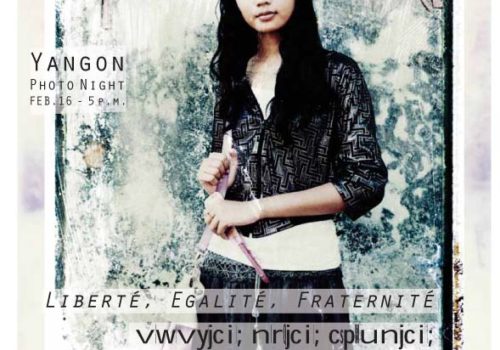Christophe Loviny is the artistic director of the Yangon Photo Festival in Myanmar and I’ve just had a talk with him about the festival and the new photography scene in this country.
Like in Cambodia (Angkor Photo Festival and Phnom Penh Photo), it is a fact that French culture is influencing the local, specially in photography. Actually for a few years many cities of the South East Asia region have been promoting new exciting and fresh events around photography and, again this often happen because of French influence. This is very strongly felt in the 5th edition of the Yangon Photo Festival. I asked Mr. Loviny which values and goals the festival wants to reach, before we can talk about the possibility of a specific and recognazible Burmese photography.
“The motto “Liberté, Egalité, Fraternité” is very much related to the changes that are happening, right now, in Myanmar and it is also related to the recent democratic process that the Myanmar people have just started discovering. But before fully enjoying the universal values of the French motto, they are also still learning them. This is why we want to exhibit these values and their concepts in many different ways.
From the first – complicated – edition of the festival (2009), we have had two purposes. Considering that the opportunity to work at the French Institute of Myanmar is probably the only place of liberty in Yangon, the first goal is to provide a training for a new generation of photographers in Myanmar. There is an active and important photographers’ association that is almost entirely focused on landscape and portraiture. Photojournalism and documentary photography is non existant, the same for artistic photography. So this is why we are doing full-immersion free masterclasses and we have been successful in training more than 150 people over the last five years. Some of them today work for Reuters, AFP or the Myanmar Times. Now – for the first time – we are doing some masterclasses outside Yangon, we did one in Mandalay last December. It’s really challenging because there the local authorities are stricter than in Yangon and it’s more difficult to take photos as well.
In our masterclasses, we are not interested in technical stuff, but how to tell stories with a journalistic and visual approach, considering also that today improving technical knowledge is easier . The final goal of the students is to produce a multimedia documentary project and the best of them will be shown to the public at the Yangon Photo Night slideshow on February 16th, the best one will be awarded by a jury headed by Aung San Suu Kyi.”
As Mr. Loviny told me, it’s very important for photographers from Myanmar to have opportunities to be exhibited here and arould the world in galleries or other festivals, but – – “it’s more important for them to have a job and be able to work with photography and storytelling. Wer are not teaching them how to illustrate, but how to tell stories in a professional and modern way using words and images.”
“The second purpose of the festival is to show to the burmese public a series of strong exhibitions by international photographers to which they would not have access in an other way. This year we have some great works, like “Freedom” by Fernando Moleres and “Intended Consequences” by Jonathan Torgovnik that are important to show in Myanmar because it’s about domestic violence, so it’s not about Rwanda only but about that private violence, so difficult to see and tell, that originates from abuses of power. Then, we also have some revelations and new talents: for the first time, we have an extraordinary and amazing project by Bruno Quinquet about “Salarymen” in Japan. Another revelation is the 20-years-old Chinese photographer Zhao Qiu Ying who did a strong work about a psychiatric hospital around Nanjing, 30 years after Lu Nan’s work about the life of mentally ill patients in China.”
Do you think it is possible to talk about a Burmese photography as, in recent times, a Bangladeshi or Cambodian photography?
“It’s too early to talk about a specific style. It has started very recently and this is the first year that we live in an apparently open democracy. But I can see that there is a strong sensibility to social themes and there is, maybe, a specific Burmese way to relate with the subjects: there is a lot of compassion and they’re quite optimistic and positive. It’s different – for example – from Bangladeshi photography, that is sometimes very dark.But if in Bangladesh you can find great photographers, in terms of technique, Burmese authors are still learning and the sensibility is very high and sincere. . They describe a reality – one of the poorest country in the region – that has very difficult situations and problems, but however it is described using an optimistic feeling.”
What is the feedback of the public, specially those not involved directly with photography?
“As the photographers, they are very touching and their sensibility is rare if not almost unique. It happens that during some screening show, a lot of people cry. It is incredible! It is the effect of compassion for the stories and the people who live the same stories.”
Eliseo Barbàra
mostartists.com
Exhibitions
Yangon Awakening – by Cedric Arnold
Democracy – by Aung Pyae, Minzayar and Pyay Kyaw Myint
Earth and Heaven – by Marianne Niermans
Freedom – by Fernando Moleres
Homage to Remi Ochlik
Intended Consequences – by Jonathan Torgovnik
Libera Me – by Zhao Qiu Ying
Paris – by Yann Layma
Salaryman Project – by Bruno Quinquet
Sangatte – by Hervé Lequeux
5th Yangon Photo Festival
Till on February 22th, 2013
Institut Francais de Birmanie
340, Pyay Road, Sanchaung Tsp
Yangon
Myanmar

















